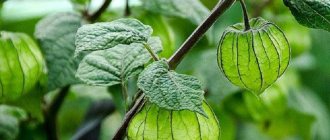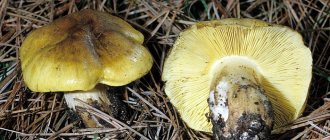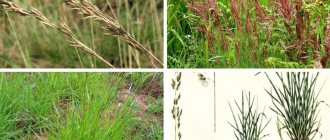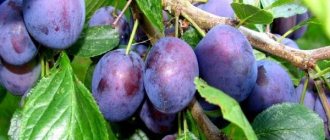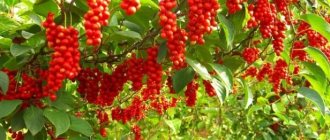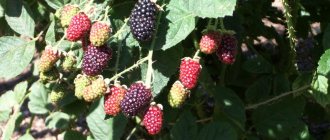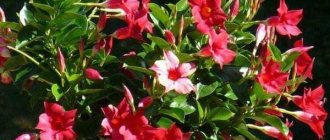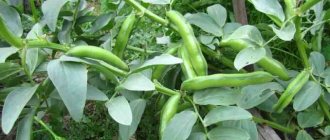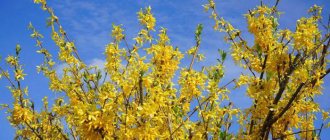The genus Physalis is the largest of the Solanaceae family. It has more than a hundred species, which are distributed throughout the globe, except Australia and Antarctica.
Representatives of this genus are annual or perennial herbs.
Their shoots are weakly branched, they may be slightly covered with fluff, and their height, depending on the species, ranges from 20 cm to 1 m and even a little higher. The base of the shoot gradually becomes woody. The foliage of this plant is mostly opposite, maybe alternate. Flowers are solitary and placed anywhere on the shoot. Under the flower lies a fruit, which in many species can be eaten. [Hide]
Varieties and types
Edible physalis is conventionally divided into vegetable and berry. And, if the Vegetable species exists, although this definition is often extended to a wider group of species, then Berry is used to designate species with sweet, dessert properties.
Physalis Peruviana is a berry variety with sweet and sour fruits. Berries of this type are not stored for a long time. The most popular varieties are Pineapple and Strawberry .
Physalis Mexicana or glutinous , or actually Physalis Vegetable, tastes more like tomatoes than others. Can grow very tall. Its berries are noticeably larger than those of other species. They can be yellow, green or purple.
Representatives of this species do not require such careful care, and they are less heat-loving than berry species, but they differ from them in taste. The most popular varieties: Confectionery , Korolek .
Ornamental physalis or Chinese lanterns, the fruits of these species are completely inedible due to toxicity, but due to their high decorative properties they are widely popular among gardeners.
The most famous is the Franchet , which reaches almost a meter in height. It has rounded, slightly oblong foliage. More than 10 flowers can fit on one stem.
Physalis Marmalade bushes of this berry physalis can grow up to one and a half meters and branch well. The berries are large, yellow or purple in color, like other species, covered with a flower.
Physalis vulgaris is a perennial that grows up to half a meter in height. This plant has white flowers that turn red when they bloom, revealing the edible fruit.
Which variety to choose
Seeds of all types of physalis can be bought in specialized stores or ordered online. When choosing, you need to pay attention to the time of fruit ripening. If frosts begin in your region in August, then varieties whose ripening period occurs in September will not be suitable if you plan to grow physalis in open ground.
The color, size and taste of physalis fruits depend on the variety
Table: the most popular varieties of physalis
| Variety name | Appearance, plant height | Fruit ripening period | Size/weight of the fruit, its taste and beneficial properties | Eating, cooking options | Features of the variety |
| Vegetable (Mexican) Physalis | |||||
| Confectioner | The plant is semi-spreading, 60–80 cm high. | Mid-early variety (from germination to the beginning of ripening 116 days), ripening time - August-September. | Fruit weight 60–80 g, smooth yellow fruit. The taste is sweet-sour, astringent. The fruits contain pectin, vitamin C, sugars, mineral salts and trace elements. | The fruits are recommended for pickling and pickling. They make jam from them. | The fruits have an increased shelf life (2–3 months) and, due to their high pectin content, have gelling properties. The plant is resistant to bacterial rot. |
| Marmalade | Up to 1.5 m high, spreading, branched plant. | Mid-season variety (from full germination to the beginning of fruiting 120–130 days), ripening time - July-August. | Fruit weight is 30–40 g, the color of ripe fruits is creamy. Fragrant fruits with plum taste. | The fruits are recommended for fresh consumption, canning, pickling, making jam and preserves. | Shade-tolerant variety. |
| Kinglet | Compact bush 60–80 cm high. | Early ripening variety (from germination to harvest 90–95 days). | Round, dense fruits weighing 60–90 g. The color of the ripe fruit is amber, the taste is sweet and sour. | The fruits are suitable both for fresh consumption and for making caviar, preserves, jams, candied fruits, homemade wine, for pickling and canning. | The variety is characterized by cold resistance and high yield. |
| Jammy | The plant is 1.4–1.6 m high, spreading, branched. | Mid-season variety (from full germination to the beginning of fruiting 110–115 days). | Green fruits weighing 50–60 g have a high gelling ability, anti-inflammatory and analgesic properties. | The fruits are recommended for making preserves, jams, pickles, and marinades. | Shade-tolerant variety. |
| Gourmand | Plant 70–75 cm high. | Early ripening variety. | A yellow, light-colored fruit weighing 120–200 g with a high content of sugars and pectin. | Fruits are recommended for processing. | Drought-resistant, cold-resistant, unpretentious variety. |
| Strawberry (hairy) physalis | |||||
| Raisin (Sugar raisin) | Plant height 80–100 cm. | Early ripening variety, ripening period July-August. | Fragrant and sweet fruits weighing up to 9 g. | The fruits can be used fresh, as well as candied fruits, jams and preserves. | The most shelf-stable variety, the berries in the sepals retain their taste for 6 months. |
| Turkish Delight | Compact, branching plants 30–50 cm high. | Early ripening cold-resistant variety. Fruit ripening occurs on the 90–95th day after germination. | The fruits are round, weighing 6–12 g. The taste is similar to strawberries and pineapple, sweet and sour, juicy and aromatic. | The fruits are suitable for fresh consumption; they are used to make jam, compote, and candied fruits. Dried fruits are used as a substitute for raisins. | The variety is easy to grow, resistant to pests and diseases, including late blight. |
| Gold placer | Compact bushes 30–35 cm high. | Early ripening variety. The fruits ripen on the 92–99th day after germination. | The fruits are round, weighing 4–5 g, juicy, sweet and sour, with the aroma of strawberry and pineapple. | The fruits are suitable for fresh consumption, for making jam and candied fruits. | A productive, long-lasting variety, resistant to diseases and pests. |
| Strawberry | Medium-sized plant up to 70 cm high. | Early ripening variety. | Round, amber-colored fruits weighing 10–15 g. Sweet, with strawberry flavor and aroma. Contain a large amount of pectin, vitamin C, mineral salts and trace elements. | The fruits are consumed fresh and dried, used for making desserts, confectionery, and jam. | A productive variety. |
| Pineapple | Medium height plant. | Early ripening. Fruit ripening occurs on the 105–119th day after full germination. | The fruit is flat-round, the color of the unripe fruit is light green, the color of the ripe fruit is cream. Fruit weight: 50–80 g. | Recommended for fresh consumption, whole-fruit canning, pickling and making preserves and jams. | Shade-tolerant. |
Physalis cultivation and care
Growing physalis and caring for it is not difficult. During the growing season, this plant needs good watering, after which it is necessary to loosen the soil and get rid of weeds.
If the summer turned out to be damp and cool, then you need to hill up the bushes; you also need to hill up if your climate in general is not very warm.
Pinching should not be carried out because the more branches the stem has, the more berries there will be and it will be difficult for the bush to bear them.
Brunfelsia is also a member of the Solanaceae family, a very pretty flower that is cultivated when cared for at home; you can find out the growing recommendations at the link.
Growing physalis from seeds
In warm places, physalis is simply sown in the soil, because this plant tolerates cold well and also reproduces by self-seeding.
It is better to take fresh seeds for sowing, although in general the seeds of this crop remain viable for up to 3-4 years. First, soak them in a 5% saline solution and discard any seeds that float to the top. After this, the seeds are washed and kept for about 30 minutes in a solution of potassium permanganate.
You don’t need to sow the seeds very thickly; when the sprouts begin to emerge, you will need to thin them out so that there is about 20-30 cm between the individuals. The torn seedlings can not be thrown away, but rather replanted.
You can also sow in open ground in mid-autumn, before winter.
Sowing physalis for seedlings
In the colder conditions of the middle zone, it would be more correct to use seedlings. The seeds are sown in half-liter pots or large boxes a month and a half before transplanting into the soil, but in this case the seedlings will need to be planted.
Germination of the material is carried out at approximately 20°C or slightly warmer. If the temperature is too low, germination will be delayed.
When germination, monitor soil moisture. Moisten the flower from time to time, but try to ensure that the water does not stagnate in the substrate and that the humidity is not high, because the seedlings can easily get sick.
If the seedlings are very weak and stretch out strongly, despite normal temperature and good diffused lighting, then they need to be fertilized with a weak solution of bird droppings (the ratio of droppings to water is 1 to 20).
Plants are planted in the soil when they have 5 leaves.
The soil for physalis must be nutritious, have neutral acidity or be slightly alkaline. The area needs good lighting.
This crop grows well in areas where cabbage is grown, and where other nightshades were previously planted, it is better not to plant it. About a month before planting seedlings in the soil, the area needs to be dug up with humus and ash. Fresh manure cannot be applied as fertilizer.
Holes for seedlings are dug such that the plant is immersed in them up to the first leaf. Planting holes are watered immediately before planting.
Why Physalis is useful: indications and contraindications for use
All parts of this plant contain many useful substances and can be used as a medicine if the instructions are followed. Thus, the fruits of physalis have an anti-inflammatory, hemostatic, analgesic effect, and are also used as a diuretic and choleretic agent.
The berries contain calcium, iron, sodium, potassium, phosphorus, zinc, and magnesium.
The juice of fresh berries serves as a medicine in the treatment of hypertension, dermatoses, and dysentery. A decoction of the fruit will help with urolithiasis, cystitis, bronchitis, rheumatism, and gout. A decoction of the roots is useful for coughs and helps relieve pain, and boiled dried leaves are useful for hypertension.
Physalis juice can also be used as a healthy seasoning that can be added to meat and fish. The fruits can be made into jam or added to the filling of pies; they are rarely eaten fresh.
Features of the use of physalis:
- Increased acidity is a contraindication. If there is a need to use physalis, then it is better for people with high acidity to start with small doses, starting with 1-2 berries, gradually increasing the dosage.
- Do not exceed the dose. You must take the poisonous external parts of physalis strictly according to the instructions, otherwise you can get seriously poisoned. Before using any components of the plant, you should consult your doctor.
- Wild physalis, growing in the middle zone, contains many toxic substances and should not be eaten.
- Before use, physalis fruits must be doused with boiling water to remove the sticky coating. Only ripe fruits can be used. They must be consumed without a bubble cup, as it is toxic.
- It must be remembered that many herbs are contraindicated during pregnancy.
Physalis diseases
Physalis gets sick much less than its relative tomato, but viral mosaic can still affect it. First of all, this happens if the plant is poorly cared for.
The virus cannot be treated and all plants from the site must be burned, and the site itself must be disinfected with potassium permanganate.
When growing seedlings, if there is excess moisture, it may suffer from blackleg .
The worst disease for nightshades is phytosporosis , which is manifested by darkening of the fruits, and appears with great dampness when the fruits ripen. To protect against this disease, the bushes are sprayed with 1% Bordeaux solution.
Disease Prevention
Shoots on which disease symptoms appear are removed. Treating seeds will help reduce the risk of developing the disease, as well as:
- compliance with crop rotation and crop care rules;
- correct collection of seed material (only from healthy plants!);
- constant pest and disease control;
- thorough preparation of the soil, removal of plant debris on which pathogenic microorganisms could remain.
The harvest is harvested when the ripe fruits begin to fall to the ground. Unripe physalis is placed in a box and put away in a cool place for ripening. The pulp – the plant “cover” – should not be removed: the fruits will last longer.
Physalis pests
mole crickets and wireworms appear most often .
The first ones are difficult to get rid of. But this pest has many natural enemies (moles, lizards, scolopendras), which usually do not allow it to multiply too much.
To avoid problems with wireworms, physalis should be planted next to legumes.
If there are a lot of pests, then you can bury bait in the form of beets or carrots. Mark these places, and after a few days, take out the bait and destroy the pests.
Before plowing the area, it can be treated with insecticides, as well as a solution of potassium permanganate.
Physalis winter recipes
Physalis is not only used for preparing salads and generally consumed raw, but is also used in canning. Here we present several recipes for preparing physalis for the winter.
To preserve vegetable physalis you need to take:
- Physalis,
- 3-4 cloves,
- allspice,
- Bay leaf,
- currant and cherry leaves,
- horseradish leaf,
- clove of garlic,
- one and a half tablespoons of sugar,
- a teaspoon of salt,
- teaspoon 9% vinegar.
All ingredients are for one half-liter jar.
First, you need to completely remove the flowers from the berries and wash them.
Place spices, sugar and salt in sterilized jars. Then lay out the physalis and pour boiling water over it. After this, the jar is left for 20 minutes. Next, the brine is drained, brought to a boil, and so on three times.
Before pouring the brine into the jars for the last time, add vinegar to it, and after that you can roll up the jars. In a couple of weeks, the pickled physalis will be ready.
Physalis jam
The fruits of physalis berry, say jam or strawberry, can be used to make jam.
Berries and sugar are taken in a ratio of 1 to 1, you will also need lemon and 200 ml of water.
The berries must be thoroughly peeled from the flower and rinsed well with hot water. The lemon is thinly cut with the peel and boiled for about 5 minutes in water.
Add half the sugar to this lemon water and cook until it is completely dissolved. After this, add the berries and cook over low heat for 10 minutes.
After this, the jam is left to infuse for 4 hours. When this time has passed, you can add some seasonings, for example, ginger, vanilla, etc. Next, the jam is brought to a boil again and cooked for 5 minutes, and then left to steep again for 6 hours.
Next, the rest of the sugar is added, and the jam is sent to the stove to boil and cook for 10 minutes. When the sugar has dissolved, you can pour it into jars.
You also don't have to use syrup. Then you need to let the berries sit with sugar and release the juice.
Physalis caviar
Physalis can be used to make excellent caviar for the winter. To do this, take a kilogram of physalis, half a kilogram of carrots, 300 grams of onions, a tablespoon of salt, one and a half tablespoons of sugar, 100 grams of tomato paste, 100 ml of vegetable oil.
Physalis is washed well and thrown into boiling water for a minute, and then cut into pieces and ground in a meat grinder.
Finely grate the carrots and chop the onions. Next, the vegetables are sent to a frying pan with vegetable oil and after frying, pureed physalis berries are mixed with them, salt, sugar and paste are added. Thus, the mixture is stewed for 20 minutes and poured into jars.
Caring for seedlings after picking and before planting in the ground
After picking, place the seedlings for a day in the shade, for example, on the floor or on a western windowsill. Then move it again to a sunny place. The appearance of young leaves will indicate that the physalis has taken root and is growing again. Now the roots are already able to get moisture from the depths of the pot, so you no longer need to worry about constant soil moisture. The condition of the lower leaves can serve as a signal for watering: if there is not enough moisture, they lose their elasticity and droop. You will have to water only 1-2 times a week with water at room temperature, soaking the entire lump of earth, that is, until the liquid begins to come out through the drainage holes.
Physalis seedlings grow on a windowsill for only 30–40 days. In such a short period, and even if you were digging into a larger volume of soil, fertilizing is not needed. The exception is when the seedlings are grown for a longer period or the physalis grows slowly and does not produce new leaves for a long time. Then, a week after picking, feed it with any complex fertilizer - for example, Fertika Lux (1 tbsp per 10 liters of water).
If physalis seedlings have outgrown the pots, you need to urgently transplant them into a larger container or to a permanent place
A week before planting, begin to harden the physalis, that is, accustom the plants to being outside, in direct sunlight. For the first time, place the seedlings for 2 hours in a shady corner of the balcony or garden. In subsequent days, take it out into the sun and gradually increase the time. Naturally, the weather should be warm - above +15⁰C and not rainy. For working gardeners, hardening should be timed to coincide with weekends or May holidays.
The day before planting in a permanent place, water the seedlings. If there is still a threat of frost, prepare a temporary shelter from arcs and film on the site. It is better to choose evening hours for landing.
